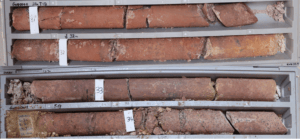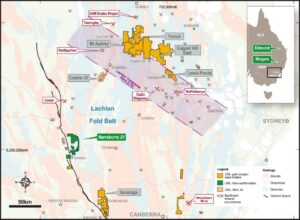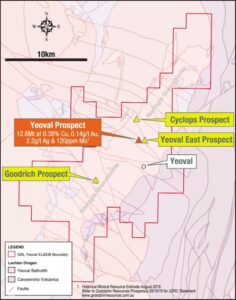Uncategorized
With a mineral resource on the way, Godolphin shows how Australian rare earths players can challenge the might of China
Special Report: With the market for electric vehicles, communications technology, wind turbines and solar panels only expected to grow as … Read More
The…

With the market for electric vehicles, communications technology, wind turbines and solar panels only expected to grow as the race to Net Zero continues, Australia is fighting to claim a key place in the global supply of rare earths.
And right on cue – in fact, in the next few weeks – Godolphin Resources (ASX:GRL) is set to unleash a major new force in the Australian critical minerals scene.
Boasting a maiden JORC 2012 resource GRL’s Narraburra project in New South Wales could go a long way to establishing our global REE credentials.
Located 15km north of Temora in the New South Wales Riverina across two exploration tenements with a total acreage of 349km2, the project has been explored since 1999, when programs by its previous owner revealed the Devonian Age rocks, upwards of 350 million years ago, to host a cornucopia of rare earth elements.
They included neodymium and praseodymium, the key light rare earth metals prized for their use in permanent magnets for EV motors and wind turbine generators.
Other critical metals included zirconium, yttrium, niobium, dysprosium, terbium, most importantly very low levels of the radioactive uranium and thorium which compromise many rare earth deposits.
Previous owners Capital Mining identified a historic JORC 2004 compliant inferred mineral resource, which has provided both a launching pad and point of reference for Godolphin.
But as managing director Jeneta Owens explains, it has also enabled Godolphin to take a different approach and re-imagine the project into one that can truly help Australia and its geopolitical allies challenge China’s dominance in the world’s rare earths supply chain.

The whole Godolphin exploration team is based in Orange, being active members of the local stakeholder community. This makes for a very nimble exploration group, able to be first movers as trends develop. The move into rare earths at Narraburra exemplifies this culture.
An advanced explorer
A maiden JORC 2012 mineral resource estimate , where Godolphin is earning into a 75% stake.
Having begun the farm in and JV with private exploration firm EX9 only in March last year, the once copper-gold explorer has moved fast to firm up its now flagship asset.
Previous explorers had looked at the deposit through a similar lens to the nearby Dubbo project, a hard rock zirconium resource in Devonian Age rocks with rare earth by-products.
At Narraburra, Godolphin is exploring a potential ionic absorption clay deposit.
Set in shallow soils which can be dug freely is a style of orebody yet to be developed in Australia, but is the primary source of rare earths in south China, and features mining and processing characteristics that make the extraction cheaper to both develop and operate.
“The similarities of Dubbo is that we’re both in the Devonian aged rocks in the Lachlan Fold Belt and that’s about where it ends,” Owens said.
“Dubbo is a rare earth enriched trachyte type of hard rock, that is a volcanic rock and it has zirconium in it that’s enriched in rare earths.
“The difference being at Narraburra, we have a granitic peralkaline granite rock that is enriched in rare earths, but what has happened is being of Devonian age, many millions of years ago, over a long period of time weathering – the process of groundwater and air interacting with subsurface rocks – creates a chemical reaction which breaks down the fresh granite and creates clays.
“During this weathering process, it releases the rare earths and they are loosely held or adsorbed in the weathered clay profile.
“So there’s a really thick, weathered clay profile sitting above the granite, and other basement rocks across the area at Narraburra. Those are the areas that are enriched in rare earths.” Owens said.
That means the expectation is the resource at Narraburra will be leachable at atmospheric pressure and slightly elevated temperatures around 500C, with drill core samples having already been sent from diamond drill core programs totaling 31 holes to the Australia Nuclear Science and Technology Organisation (ANSTO) for test work.
“Fundamentally hard rock rare earth projects are not leachable at atmospheric pressure where Narraburra is, and our resource that was defined in 2011 was completely open and all drilling to date has not defined the extents of the actual mineralised resource.

Critical minerals – The Australian dream
The promise of clay-hosted rare earths deposits like Narraburra is that Australian miners could become cost competitive on a global level without the billion dollar plus capex bills for projects like Dubbo or Lynas’ Mt Weld mine in WA.
Unsurprisingly this kind of critical mineral development is of extreme interest to officials and the focus of vigorous government investment. Notably the US 2022 Inflation Reduction Act (IRA) requires the US and its supply chains in the battery, electric vehicle and wind turbine sectors to use US, Australian and Canadian rare earth supply chains. Europe is heading in the same direction.
Canberra issued a $1.25 billion loan to get Iluka Resources’ Eneabba rare earths refinery off the ground last year, and established the $2 billion Critical Minerals Facility in 2021 to accelerate investment in metals key to the global energy transition.
“At the moment, those resources pretty much 100 per cent come from China, and with the political environment as it is across the world, other countries have seen that this is a real risk to supply chains,” Owens said.
“So there’s a global appetite to source raw materials for future technologies outside of China. And it’s not just sourcing them, it’s also the downstream processing.
“Now, the Australian government in the past couple of years has really put a focus on this as well.
“The Australian Government has set aside funding for these types of projects to help expedite the development pathways – and being geopolitically stable here in Australia, – countries such as Germany and other EU nations and the Americans really look on Australia favorably as being a place that they can source these natural resources and most importantly, comply with the IRA.”
Owens says downstream processing within Australia could be achievable with clay rare earth deposits.
“There’s hard rock and clay, and they take totally different processing paths. Hard rock is capital-intensive, you can be talking over a billion dollars to get a project off the ground in capital expenditure,” she noted.
“Whereas the clay-hosted deposits are actually much less capital-intensive, they’re in the range of 10s of millions to hundreds of millions rather than billions of dollars.
“The clay deposits are leachable, you dig them up, you put them in tanks, apply acid, and you can leach out the rare earths.
“That’s why it’s really attractive to Australian markets at the moment. We can get to production quite quickly, it’s not tens of years building infrastructure or getting approvals for mining projects.
“It’s quite simple. Dig it up, leach it and then you’ve got a REE enriched pregnant liquor solution. After that the downstream processing to individual REE powders is more simplistic than hard rock processing and that’s something that’s achievable within Australia now also.”
These kinds of deposits were not explored 15-20 years ago in Australia, but the growth of the rare earths market and demand from the EV and wind turbine sectors has opened a new window for Aussie explorers.
Forest for the REEs
Godolphin was able to take a fresh look at Narraburra to find something others had missed.
Drilling by GRL outside the boundaries of known mineralisation have shown rare earth oxides are more abundant than previously known.
Results from assays received in December 2022 indicated as much. These include: 7.1m at 1,218ppm total rare earth oxides (TREO) from 38.9m, 1m at 668ppm TREO from 3m and 2m at 1,238ppm TREO from 15m all outside the JORC 2004 resource envelope.

Further results in January 2023 demonstrated high levels of TREO were found in shallow weathered rock zones, which could provide cost effective near term extraction opportunities once developed, including 17m at 508ppm TREO from 34m and 14m at 525ppm TREO from 35m outside of known mineralisation and a wide hit of 72.3m at 687ppm TREO from 27m infilling the known mineralised zone.
Even better, results from another 22 holes reported in mid-January included some of the best grades to date, such as 3m at 3,481ppm TREO from 31m, 1m at 5,182ppm TREO from 34m and 2m at 4,495ppm TREO from 52m and 1m at 7,956ppm TREO in the same hole from 61m, the latter containing 1,090ppm neodymium and 240ppm praseodymium alone which are exceptional assays highlighting Narraburra’s potential.
“What we could see is that the overlying unconsolidated clays are the host of the rare earths and those kinds of deposits weren’t really explored for in Australia back in the 2000s,” Owens said.
“Being in our own backyard here in New South Wales, very close to our current tenement package, we identified this project that had known mineralisation, hadn’t been worked on recently, with a modern approach, we could see that we could add value to the project quite quickly.
“It was a no brainer, really, for the company to take it on. We knew we could update that mineral resource estimate with minimal drilling and potentially look at the deposit style from a different perspective.”

Horses in the race
Godolphin is by no means a one trick pony.
Founded originally to place a singular focus on the New South Wales gold and copper projects in the stable of Kalgoorlie nickel explorer Ardea Resources (ASX:ARL), the company has expanded quickly in just three years on the ASX boards.
At the Lewis Ponds project, just 20km from gold major Regis Resources’ (ASX:RRL) 2.3Moz McPhillamys deposit, Godolphin boasts a polymetallic resource consisting of 6.2Mt at 2g/t gold, 80g/t silver, 2.7% zinc, 1.6% lead and 0.2% copper.
Previously mined from the early 1800s to the 1920s, work is ongoing to expand that resource.
Alongside that the Yeoval project is also a standout, with a JORC 2012 mineral resource estimate of 12.8Mt at 0.38% Cu, 0.14g/t Au, 2.2g/t Ag and 120ppm molybdenum.
Rock chip samples, new holes and relogged historical drill core have provided evidence of more high grade copper mineralisation outside the existing resource.
The whole show bag
The diverse range of advanced copper, rare earths and gold projects within its portfolio gives Godolphin a distinct point of difference, Owens says.
“As a junior explorer we really do stand out because most junior explorers are lucky to have one advanced project and when we put out this rare earth resource we’ll have four MREs, one being rare earths, two focused on gold and one on copper, which is quite amazing,” she said.
“And if you look at our market cap, it really pales in comparison to the company’s peers.
“That’s out of our hands to a degree, it is what the market is at the moment, I do see that there’s obviously a lot of potential upside for Godolphin and what we actually have in our tenement package and our portfolio.”

Copper for the future
Like rare earths, Owens is optimistic about the outlook for copper, with Yeoval one of a handful of resources of substance across Australia heading into what is expected to be a major shortage for the metal, key to electric vehicles, wiring and renewable infrastructure.
“All predictions are that there’s going to be a worldwide shortage of copper by 2030. We are glad to be in this space where we have these advanced copper projects and targets,” Owens said.
“It’s a great area to be in when you’re walking around some of our Yeoval prospects and you see copper minerals at surface, it’s a really exciting time.
“From a geologist’s perspective, it doesn’t get much better than that to be honest. Being able to move these projects forward is going to be critical for the world’s supply of copper.”
On top of that, this is a management team with both operational and exploration expertise.
Prior to her appointment as managing director of Godolphin, Owens led exploration activities at the major Northparkes copper and gold mine in New South Wales as well as Sandfire Resources’ exploration initiatives in the state.
Stepping onto the board recently, Chris Hartley has also bought a wealth of experience to drive the processing side of the rare earths picture.
A former global practice leader of processing for BHP based in London, Dr Hartley’s later role as technical director of strategic materials for a lower carbon energy provider in California included developing process technologies applicable to the commercialisation of ionic clay rare earth deposits.
This article was developed in collaboration with Godolphin Resources, a Stockhead advertiser at the time of publishing.
This article does not constitute financial product advice. You should consider obtaining independent advice before making any financial decisions.
The post With a mineral resource on the way, Godolphin shows how Australian rare earths players can challenge the might of China appeared first on Stockhead.
asx
gold
rare earths
ree
yttrium
praseodymium
neodymium
terbium
dysprosium
rare earth oxides
copper
zinc
molybdenum
niobium
diamond














